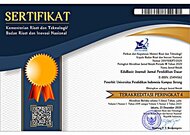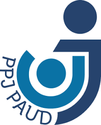Understanding Social Studies Concepts through Circuit Learning Models and Creative Problem-Solving Models in Fifth Graders
Abstract
This study aimed to determine the development of social studies learning concepts between students who use the circuit learning model and students who use the Circuit Learning model process using the Creative Problem-Solving method in fifth-grade social studies learning in the 2022- 2023 academic year. This research uses a quasi-experimental method and the results of the ability to understand the concept of social studies data collected through a test description or essay. To analyze the differences between those two learning methods, the t-test with a significant level of 0.05 (5%) was used. After being taught using the Circuit Learning model and Creative Problem-Solving models, the results of the ability to understand the concept of social studies have a difference. Students who use the circuit learning model get an average score of 82.1, while students who use the problem-solving method get an average score of 72.86. Based on the results of the analysis of hypothesis test data using the t-test at a significant level of 0.05 (5%) obtained tcount > ttable is 3.80 > 1.686 so H1 is accepted and H0 is rejected. Students who use the circuit learning model have a better understanding of social studies concepts than those who use the creative problem-solving model. They are more confident in learning, making it easier for them to understand social studies concepts because they learn collaboratively and competitively and are responsible for their responsibilities in the group.
Keywords
Full Text:
PDFReferences
Aeniah, B. (2020). Meningkatkan prestasi belajar IPS materi mengenal cara menghadapi bencana alam dengan model cooperative tipe circuit learning siswa kelas VI semester I SDN Batu Kembar Kecamatan Janapria tahun pelajaran 2015/2016. JISIP (Jurnal Ilmu Sosial dan Pendidikan), 4(1), 222–229.
Azizah, Z. N., & Santoso, B. (2023). Pengaruh creative problem solving (CPS) Terhadap kemampuan berpikir kreatif ditinjau dari minat belajar. Jurnal Pendidikan Ekonomi Undiksha, 15(1), 1–8.
Desiana, L., Patonah, R., & Ilah, I. (2021). Pengaruh metode circuit learning pada mata pelajaran ekonomi. J-KIP (Jurnal Keguruan dan Ilmu Pendidikan), 2(3), 69–76.
Farisi, M. I., & Malik, A. (2015). Pendidikan IPS sebagai “synthetic discipline”: kajian epistemologis atas pemikiran Nu’man Somantri. Cakrawala Pendidikan, 34(1), 128–139.
Faturohman, I., & Afriansyah, E. A. (2020). Peningkatan kemampuan berpikir kreatif matematis siswa melalui creative problem solving. Mosharafa: Jurnal Pendidikan Matematika, 9(1), 107–118.
Haq, A. N., Uswatun, D. A., & Maula, L. H., (2019). Penerapan model circuit learning untuk meningkatkan kemampuan berpikir kreatif pada pembelajaran IPS di kelas tinggi. Jurnal Utile, 5(2), 104–114.
Harefa, D., Telaumbanua, T., Sarumaha, M., Ndururu, K., & Ndururu, M. (2020). Peningkatan hasil belajar IPA pada model pembelajaran creative problem solving (CPS). Musamus Journal of Primary Education, 3(1), 1–18.
Hidayat, S., Tati, A., & Hotimah, H. (2022). The effect of using social science learning videos on learning interest elementary school student of 5th grade. Excellent Education, Science and Engineering Advances Journal, 1(2), 49–59.
van Hooijdonk, M., Mainhard, T.,, Kroesbergen, E. H., & van Tartwijk, J. (2020). Creative problem solving in primary education: Exploring the role of fact finding, problem finding, and solution finding across tasks. Thinking Skills and Creativity, 37,100665.
Husadati, S. F. D., Purnamasari, V., & Royana, I. F. (2019). Pengaruh model circuit learning (CL) terhadap hasil belajar siswa pada mata pelajaran IPS. International Journal of Elementary Education, 3(3), 358–365.
Indarto, P., Jariono, G., Faiz, M., Muhammad, R., & Minawati, D. E. M. (2021). Circuit learning model based "Akidah" in modified volleyball for elementary school students. Kinestetik: Jurnal Ilmiah Pendidikan Jasmani, 5(1), 71–79.
Jariono, G., Nugroho, H., Hermawan, I., Fachrezzy, F., & Maslikah, U. (2021). The effect of circuit learning on improving the physical fitness of elementary school students. International Journal of Educational Research & Social Sciences (IJERSC), 2(1), 59–68.
Jusmawati, J., Satriawati, S., Irman, R., Rahman, A., & Arsyad, N. (2021). The impact of creative problem-solving learning model based android towards learning outcomes of elementary school students. Journal of Physics: Conference Series, 2123, 012045.
Mulyaningsih, L., Rufi’i, R., & Walujo, D. A. (2021). Project based learning dan contextual teaching and learning serta gaya belajar pada ilmu pengetahuan alam. Edcomtech: Jurnal Kajian Teknologi Pendidikan, 6(1), 110–123.
Paranna, M., & Airlanda, G. S. (2020). Pengaruh model pembelajaran circuit learning berbantu multimedia dan media sederhana terhadap kreativitas siswa. Jurnal Riset Pendidikan Dasar, 3(1), 57–63.
Pramita, P. A., Sudarma, I. K., & Murda, I. N. (2019). Pengaruh model pembelajaran circuit learning berbantuan media flip chart terhadap hasil belajar IPA. Jurnal Ilmiah Pendidikan Profesi Guru, 2(1), 20–31.
Pramestika, R. A., Suwignyo, H., & Utay, S. (2020). Model pembelajaran creative problem solving pada kemampuan berpikir kreatif dan hasil belajar tematik siswa sekolah dasar. Jurnal Pendidikan: Teori, Penelitian, dan Pengembangan, 5(3), 361–366.
Romaliyana, R. Y., Putra, M., & Sujana, I. W. (2019). Pengaruh model pembelajaran circuit learning berbantuan media flipchart terhadap kompetensi pengetahuan IPS siswa kelas V. Media Komunikasi FPIPS, 18(1), 22–30.
Salbi, A. (2021). Increasing student’s learning interest in social science learning through a cooperative approach of jigsaw engineering fourth class elementary school 2 Sepunggur-Tanah Bumbu. International Journal of Educational Research and Social Sciences (IJERSC), 2(5), 1181–1188.
Simanungkalit, K. M., & Rajagukguk, W. (2022). Application of mathematics learning model creative problem solving that assisted with desmos to improve students’ critical thinking skills of SMKN 14 Medan. Formosa Journal of Science and Technology, 1(8), 1185–1200.
Taryunita, D. A., & Japa, I. G. N. (2020). Model circuit learning berbantuan media audio visual terhadap kompetensi pengetahuan IPS Siswa Kelas V SD. Jurnal Pedagogi dan Pembelajaran, 3(3), 439–448.
Wardani, K. S. K., Rahmatih, A. N., Sriwarthini, N. L. P. N., Nurwahidah, N., & Astria, F. P. (2020). pengaruh model pembelajaran creative problem solving terhadap hasil belajar siswa. EduMatSains : Jurnal Pendidikan, Matematika dan Sains, 5(1), 9–18.
DOI: https://doi.org/10.17509/ebj.v5i2.53226
Refbacks
- There are currently no refbacks.
Copyright (c) 2023 Universitas Pendidikan Indonesia
This work is licensed under a Creative Commons Attribution 4.0 International License.
This journal is indexed by




.png)




.png)
1.png)


1.png)

.png)